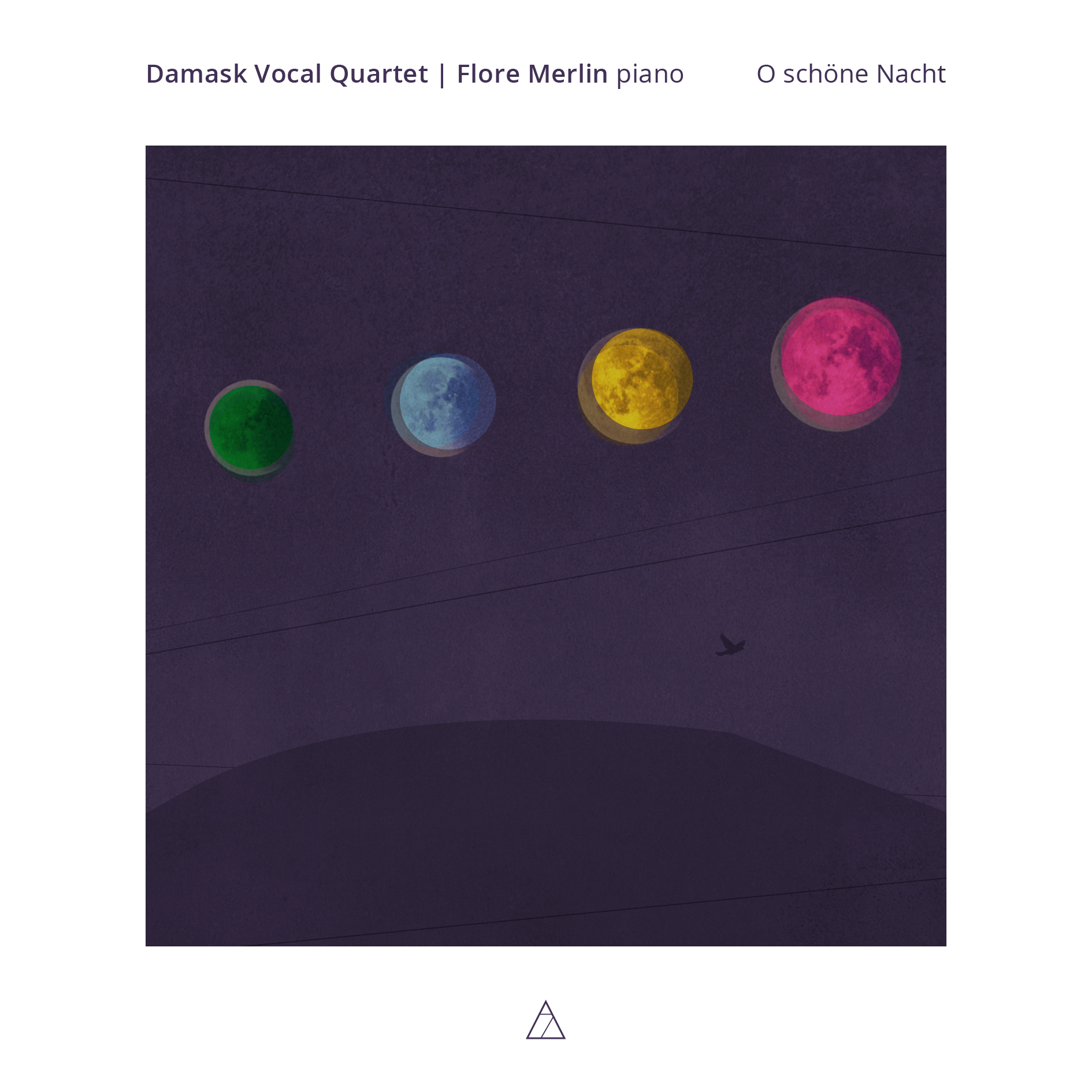O schöne Nacht
“lively and convincing ... phenomenal”
Damask released its first CD on 30 November 2018: O schöne Nacht. The album is a collaboration with French pianist Flore Merlin and award-winning Dutch producer/engineer Frerik de Jong of 7 Mountain Records and has been universally praised in the press: “Praise to Damask, who with the French pianist Flore Merlin have ensured a perfectly executed, imaginative recital, recorded flawlessly by Frerik de Jong, which certainly leaves us wanting (much) more.” (Aart van der Wal, OpusKlassiek)
—
In the summer of 2019, O schöne Nacht won the prestigious French award Choc de Classica. Click here to read the full review.
“Damask Vocal Quartet, a true ensemble and not just a gathering of four individuals ... offers a remarkable fusion of timbres and palpable collaborative energy. We are seduced from the outset by these flexible voices.”
“Elk lid heeft een solide solistenstem, maar niemand domineert het klankbeeld; de zang is aldoor evenwichtig en harmonieus. ... Het Damask Vocal Quartet bewijst met deze eerste cd dat het niet alleen bekoorlijk kan zingen, maar ook origineel kan programmeren. Graag meer!
Each member has a solid solo voice, but no one dominates the sound; the singing is always balanced and harmonious. Damask Vocal Quartet shows with this first CD that not only is their singing charming but their programming is original. More, please!”
ABOUT THE PROGRAM
The CD is a collection of quartets and solo piano pieces by late 19th-century composers themed around night. The centerpieces of the disc are three complete quartet cycles by Johannes Brahms: Op. 31, 92, and 112. These cycles contain such favorites as “O schöne Nacht,” the CD’s title track, and “Der Gang zum Liebchen,” one of Damask’s favorites to perform and record. When we were considering repertoire for our debut album, we knew Brahms would be a perfect fit for our sensibility as a quartet, which combines the power and vocal color of four soloists with a uniquely sensitive and unified ensemble sound. These pieces are popular with choirs, and occasionally are given ad-hoc performances with four singers, but haven’t received their due in a dedicated quartet situation; this album will provide a crucial missing link in the recorded canon.
These more well-known pieces by Brahms are set off by striking works of three of his lesser-known contemporaries: Heinrich von Herzogenberg, Gustav Jenner, and Theodor Kirchner. Herzogenberg’s music is intoxicatingly rich, lush, and romantic; his four Notturnos Op. 22 are a real discovery and an enormous pleasure to sing and listen to. Jenner was Brahms’s only formal student, and his music is intensely dramatic and text-driven, looking forward almost toward Schoenberg in its daring effects. Excitingly, O Schöne Nacht presents the premiere recording of four piano pieces by Kirchner, his Notturnos Op. 28. Kirchner’s name is undeservedly obscure: these four short pieces are unabashedly operatic in scope, probing and individual and simply gorgeous, worthy companions to the passionate vocal music of the rest of the CD.
ABOUT THE PIANO
We searched long and hard for the perfect instrument to record on, and we got very lucky in the end: we were able to borrow and use an original 1868 piano by Streicher, a piano maker Brahms highly valued. From the early 1860s, Brahms preferred Streicher pianos in performance and acquired one as a gift from the maker in 1872. He praised the instrument’s “transparent tone which begins with a distinct articulation from the soft-surfaced hammers hitting the strings. The tone is more sustained and mellow, yet lush and full in sound. There is a distinct contrast in tone color between soft and loud, which makes it ease to separate a melody from its accompaniment.” For our own part, we found that this gorgeous piano, which has been lovingly maintained, make the music sparkle in a way we had never heard even on the best modern instruments; it has a particularly rich and exciting range of color in the bass and a singing and lyrical treble. The owner, Piet van Kuijken, granted us unusual permission to work with his instrument, which has only been recorded once before, and we are very grateful to him and very excited for you to hear the beautiful result.

